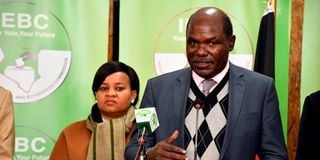Premium
Days of sour atmosphere and mistrust at the national tallying centre

IEBC Chairman Wafula Chebukati who has said that the commission will only start posting results of the presidential election from various polling stations in the country once it has verified the forms 34A as transmitted by the presiding officers.
The constituency returning officers present the physical Forms 34A to the national tallying centre, which this year was at Bomas of Kenya. It took days for them to conclude local races then travel to Nairobi. Once at Bomas, many spent nights awaiting their turn to present the constituency results.
The verification process was rather tedious. Once in, the forms were shared with agents of the presidential candidates, who scrutinised them to ensure they were the ones issued at the polling station. This was to ensure no changes were introduced in transit.
Waiting in the queue, sitting in the hall for days and sometimes sleeping in their cars must have been a tough experience. One would have expected better arrangements, perhaps a campus within a campus, where one could take a shower and rest as they await their turn to submit. Or perhaps a secure depository, where the officers could leave their all-important documents and not have to guard them with their lives.
The tally started reasonably enough, but it was not long before things turned opaque. The first to go was the display of the cumulative tally. The commonsense approach would have been to add each constituency result once scrutinised and announced and display the running total. This would have eliminated the last-minute surprise. Half-way through the tally, this approach was abandoned.
Differing tallies
You will recall IEBC chairperson Wafula Chebukati explaining why various media houses had differing tallies. He explained that this arose from the sequence that different media houses were using as they tallied using the already publicly available Forms 34A.
Political competition is a low trust environment. As if determined to amplify the mistrust, the IEBC, or Mr Chebukati acting by himself, on Saturday varied the sequencing of scrutiny and restricting access by politicians. At the start, forms would be sent to the floor first.
After scrutiny by the agents, they would then be submitted to the chairman. Claiming this was causing delays, the IEBC changed the process so that arriving forms would go to the chairman first.
Secondly, the commission restricted access to Bomas by political leaders, including accredited agents and those who had just won their own seats. This action seemed to target the Azimio coalition. The commissioners on Saturday afternoon and into the night felt political leaders were causing too many interruptions and feared they could not complete the tally on Sunday.
On arrival on Sunday morning, the leaders were locked out. The standoff continued for about four hours. The commissioners realised their folly and let the political leaders in. But by then, serious damage had been done to the credibility of the tally. The atmosphere was quite sour over the last two days of the tally.
But the worst was yet to come. Mr Chebukati refused to allow the agents to see the final tally sheet to satisfy themselves as to its accuracy, sparking the final confrontation. And with it, the commission, and the country, was split right down the middle.
@NdirituMuriithi is the outgoing Governor of Laikipia





